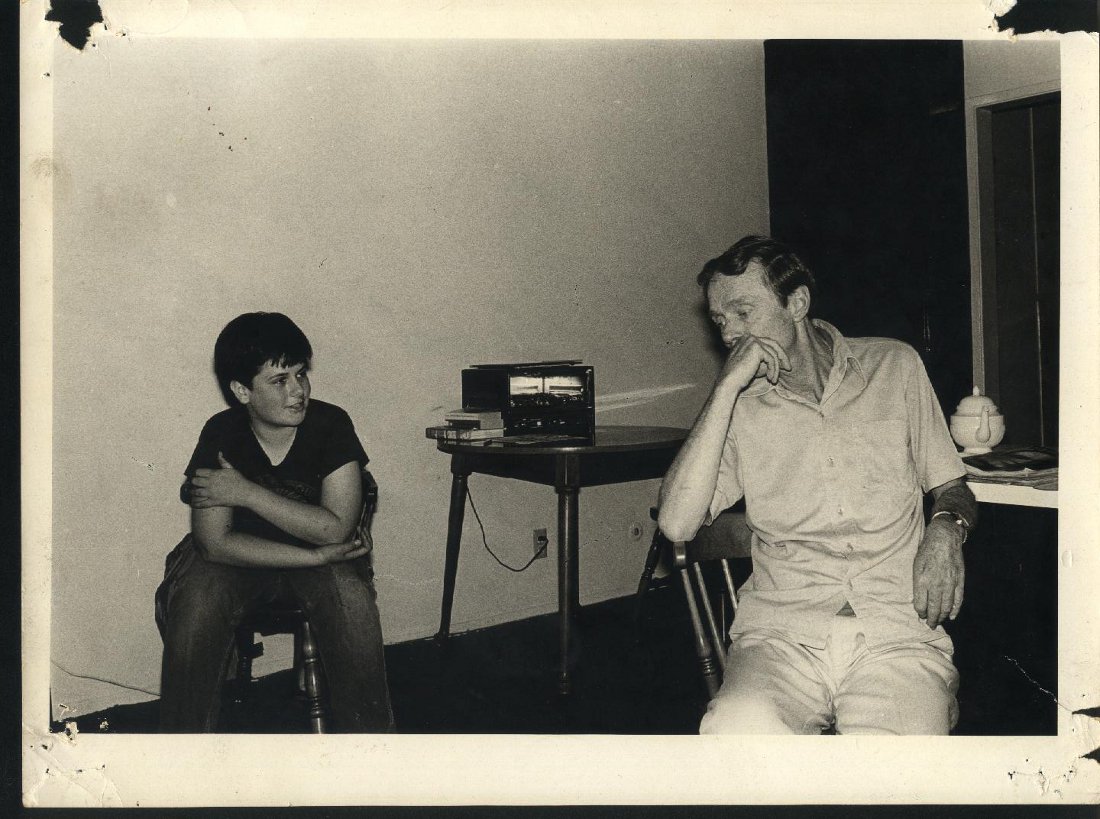Waiting Period (20 page)
Authors: Hubert Selby

Selby in 1943, shortly before he forged his birth certificate and enlisted in the Merchant Marine, an act that would change his life forever. Selby’s ship was responsible for transporting cattle to troops during World War II. It was soon discovered that the cattle were infected with the bacterium that causes tuberculosis in humans. Selby contracted the disease and was taken off of the ship in Germany. Back in New York, he was admitted to a sanatorium and told he had three months to live. “I was in the hospital and this so-called specialist consultant came by,” he remembered. “He wouldn’t come in the room. He just stood out in the hall and he said, ‘You know there's nothing we can do for you, you just don’t have any lungs, you can't possibly live. So just go home and sit in a chair and be as comfortable as you can, because you’re gonna die.’ And he walked away and sent me a bill!”

Selby with his cousin Adalin, who was named after his mother, in the 1940s.

A 1975 passport photo of Selby. The following year he published his third novel,
The Demon
. It received negative reviews but has since become a cult classic. Selby speculated that critics did not like the fact that the novel depicted the spiritual emptiness of American middle-class life. “I am obviously attacking the American Dream,” he told John O’Brien in an interview. “The old clichés. The very foundations of our nation. They don’t want to hear that.”

Selby and his third wife, Suzanne, with their son, Bill, in 1970. The family lived in a triplex in West Hollywood. At the time Selby was working on his second novel,
The Room
, which many consider his masterpiece. “Cubby asked me to marry him the night we met in 1967 and continued to ask me for two years,” says Suzanne. The couple married two years later at the suggestion of Selby’s AA sponsor. Although both had struggled with addiction in the past, they remained clean and sober for their entire marriage, which lasted thirty-five years. (Photo courtesy of Bill Shumate.)

Selby with his son Bill in 1983. During these years the family lived on welfare, as Selby made little money from his writing and remained largely ignored by the literary establishment. “I’ve never gotten a fellowship, I’ve never gotten a grant, I’ve never gotten anything,” Selby once said. In his forties he went to work as a gas station attendant, and later, in his fifties, as a hotel clerk.

A photo of Selby with his mother, Adalin, at a party for the 1988 film premiere of
Last Exit to?Brooklyn
in Munich, Germany. Selby’s mother was a strict disciplinarian and a devout Christian who “sang in the same choir for more than sixty years.” According to Selby, she responded deeply to the world depicted in
Last Exit to Brooklyn
, despite the novel’s explicit language and violence. “She said: ‘Oh, those poor people,’” Selby recalled. “I
really
must have succeeded,” he continued, “in doing what I planned to do. And that is: to put the reader through an emotional experience, because the experience of reading that book transcended all her prejudices, her ideas, her beliefs, and she just responded to the pain of the people.”

Selby with his son Kyle, from his first marriage to Inez Taylor, and granddaughter in 1997. Altogether Selby had four children and twelve grandchildren.

Selby with his grandchildren Kimberly and Joseph in 1999.

Selby with Darren Aronofsky, who directed the film adaptation of
Requiem for a Dream
, in 2000. “I needed to make a film from this novel,” Aronofsky wrote, “because the words burn off the page. Like a hangman’s noose, the words scorch your neck with rope burn and drag you into the sub-sub-basement we humans build beneath hell.” Selby felt that Aronofsky’s film did justice to his work. After seeing it at the Cannes Film Festival he burst into tears. “It was so moving,” he explained. “It is such an emotional film, so powerful.”
Requiem for a Dream
is widely regarded as one of the best novels ever written about substance abuse. Selby’s profound understanding of addiction was surpassed only by his will to overcome the disease in his own life. The month before he passed away, doctors offered him morphine to help relieve his pain—but he refused. He wanted, he said, to retain his clarity.
All rights reserved under International and Pan-American Copyright Conventions. By payment of the required fees, you have been granted the non-exclusive, non-transferable right to access and read the text of this ebook onscreen. No part of this text may be reproduced, transmitted, downloaded, decompiled, reverse engineered, or stored in or introduced into any information storage and retrieval system, in any form or by any means, whether electronic or mechanical, now known or hereinafter invented, without the express written permission of the publisher.
This is a work of fiction. Names, characters, places, and incidents either are the product of the author’s imagination or are used fictitiously. Any resemblance to actual persons, living or dead, businesses, companies, events, or locales is entirely coincidental.
Copyright © 2002, 2003, 2005 by Hubert Selby Jr.